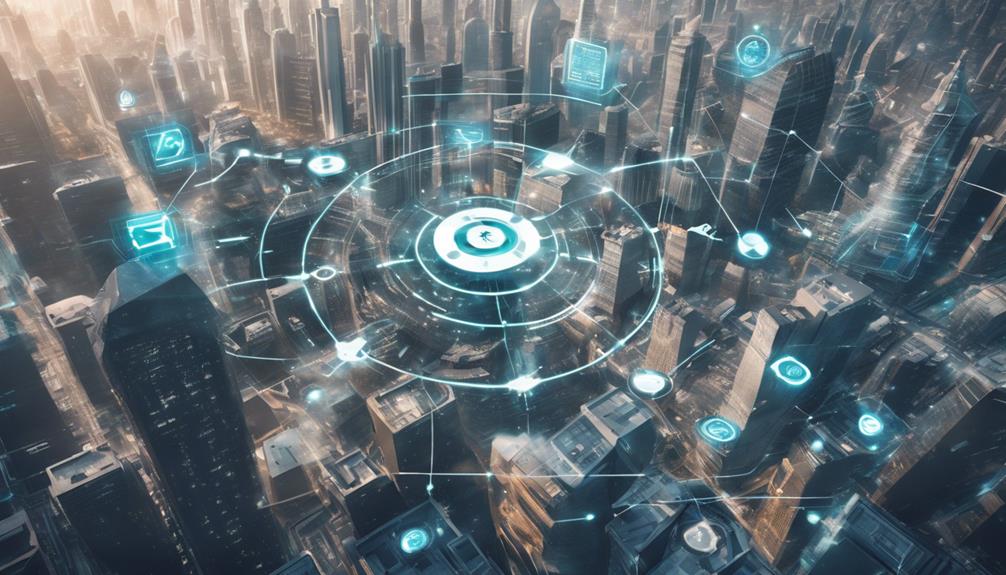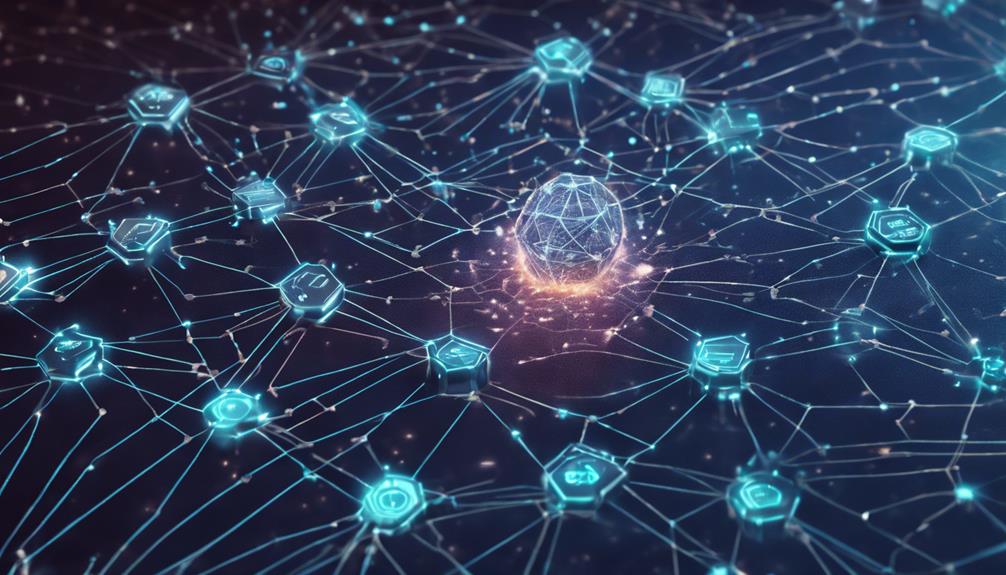The AI for cybersecurity market is rapidly expanding, with a global size hitting USD 16.48 billion in 2022. Forecasted to reach $60.6 billion by 2028, the industry presents significant growth potential. Machine Learning leads with a 46.7% revenue share, transforming practices like fraud prevention. AI adoption is surging, enhancing threat detection capabilities and defense mechanisms. Collaboration between humans and AI, quantum-resistant encryption, and blockchain integration are among long-term strategies. Explore how AI fortifies cybersecurity and stay ahead of evolving threats.
Key Takeaways
- Forecasted global market value to reach $60.6 billion by 2028.
- Short-term roadmap focuses on automating incident response tasks.
- Integration of AI, cognitive computing, and automation strengthens defenses.
- Collaboration between humans and AI optimizes security operations.
- Implementing quantum-resistant encryption and blockchain fortifies data protection.
Market Analysis and Trends
Within the domain of cybersecurity, the market analysis and trends surrounding AI technologies present a landscape of rapid growth and strategic advancements. Artificial intelligence in cybersecurity has seen remarkable progress, with the global market size reaching USD 16.48 billion in 2022. Machine Learning (ML) has particularly excelled, leading with a significant 46.7% revenue share in the same year, primarily driving advancements in fraud detection capabilities.
Regions like North America, holding a substantial 38% revenue share, and Europe, offering growth opportunities due to robust government policies, have played pivotal roles in fostering the adoption of AI technologies for cybersecurity.
The BFSI sector, in particular, has emerged as a key market for AI-driven cybersecurity solutions, focusing on enhancing fraud detection mechanisms and bolstering risk management practices. The utilization of AI technologies like Natural Language Processing (NLP) and ML is becoming increasingly critical for organizations to proactively safeguard against cyber threats with high accuracy.
Industry Growth Forecast

The trajectory of the AI for Cybersecurity market points towards exponential growth and technological evolution in the coming years. With a forecasted global market value of $60.6 billion by 2028 and a projected Compound Annual Growth Rate (CAGR) of 21.9% from 2023 to 2028, the industry growth outlook is robust. This growth is primarily fueled by the increasing adoption of AI-based cybersecurity solutions, particularly in real-time threat detection mechanisms that leverage Artificial Intelligence (AI), Machine Learning (ML), and cloud integration.
The short-term roadmap, spanning from 2023 to 2025, emphasizes the automation of incident response tasks and the implementation of AI-driven threat intelligence platforms.
Looking ahead to the mid-term roadmap (2025-2028), there is a focus on integrating AI, cognitive computing, and automation technologies.
As the industry progresses towards the long-term roadmap (2029-2030), collaboration between humans and AI, quantum-resistant encryption, and blockchain technology are anticipated to shape the future landscape of cybersecurity. The industry's growth forecast is indicative of a dynamic and innovative sector that continues to evolve to counter emerging cyber threats effectively.
Technology Adoption and Impact

The adoption of AI in cybersecurity is projected to surge, with a forecasted CAGR of 21.9% from 2023 to 2028.
This growth is primarily driven by the machine learning (ML) segment, which dominated with a 46.7% revenue share in 2022.
The impact of AI technologies, such as natural language processing (NLP) and ML, is revolutionizing cybersecurity practices, particularly in combating fraud, phishing attacks, and fake records.
AI Adoption Rate
With a global AI adoption rate of 96% in cybersecurity as of 2021, the rapid integration of AI technologies is reshaping the industry landscape. This surge in AI adoption is driven by the pressing need for enhanced threat detection capabilities. The implementation of AI has resulted in a notable 12% reduction in false positives, greatly improving the efficiency of cybersecurity operations. Additionally, AI has demonstrated a remarkable 93% enhancement in identifying previously unknown threats, underscoring its crucial role in bolstering cybersecurity defenses.
Cybersecurity professionals are increasingly recognizing the benefits of AI adoption, with 68% acknowledging a substantial improvement in their organizations' ability to detect and respond to cyber threats effectively. This widespread acceptance highlights the pivotal role that AI plays in fortifying cybersecurity postures. As the adoption of AI continues to proliferate, organizations are better equipped to achieve real-time threat detection, automate incident responses, and leverage predictive analytics for proactive defense strategies.
The projected CAGR of 31.38% from 2021 to 2026 underscores the sustained growth and impact of AI technologies in cybersecurity.
Cybersecurity Enhancements
Amidst the evolving landscape of cybersecurity, the adoption of AI technologies is revolutionizing the industry's approach to threat detection and defense strategies.
AI integration in cybersecurity not only leads to enhanced threat detection capabilities but also enables proactive defense mechanisms. Technologies such as machine learning and natural language processing are pivotal in bolstering cybersecurity measures, automating incident response tasks, and improving overall security posture.
By harnessing AI-driven cybersecurity solutions, organizations can minimize attack surfaces, automate threat identification processes, and enhance response mechanisms to a great extent.
The impact of AI on cybersecurity extends to offering predictive analytics that empower businesses to anticipate and mitigate potential cyber threats effectively. This transformative shift towards AI-powered cybersecurity enhancements is crucial in today's digital landscape, where the proactive identification and mitigation of threats are essential to safeguarding sensitive data and ensuring operational continuity.
Industry Impact
AI-driven technological advancements have greatly reshaped the landscape of cybersecurity, influencing various industries and sectors. In particular, the BFSI sector has seen a significant transformation with the adoption of AI tools focusing on fraud detection and risk management.
Machine learning holds a substantial 46.7% revenue share in the AI cybersecurity market, indicating its pivotal role in enhancing security measures. The rising demand for AI in government and defense sectors following cyber incidents highlights the growing importance of advanced technologies in safeguarding sensitive information.
AI tools play an essential role in combating various cybersecurity threats such as fraud, phishing, and fake records. Their ability to analyze vast amounts of data in real-time enables quicker detection and response to potential breaches.
As the market continues to expand, organizations across industries are recognizing the value of integrating AI-driven solutions into their cybersecurity strategies to stay ahead of evolving threats and protect valuable assets.
Key Drivers and Challenges

The increasing demand for AI-driven cybersecurity solutions arises from the global surge in cyberattacks. Organizations are increasingly turning to AI cybersecurity tools to strengthen their defenses and stay ahead of constantly evolving threats. The adoption of artificial intelligence, machine learning, and cloud integration is driving market growth by enabling real-time threat detection capabilities, providing a proactive approach to cybersecurity.
However, challenges persist in fully leveraging AI to detect insider cyber threats within organizations. Additionally, the lack of interoperability among existing cybersecurity systems poses a barrier to seamless AI integration.
Despite these challenges, there is a significant opportunity in the market as small and medium enterprises move towards cloud-based cybersecurity solutions, creating growth prospects for AI in cybersecurity.
Vertical Market Insights
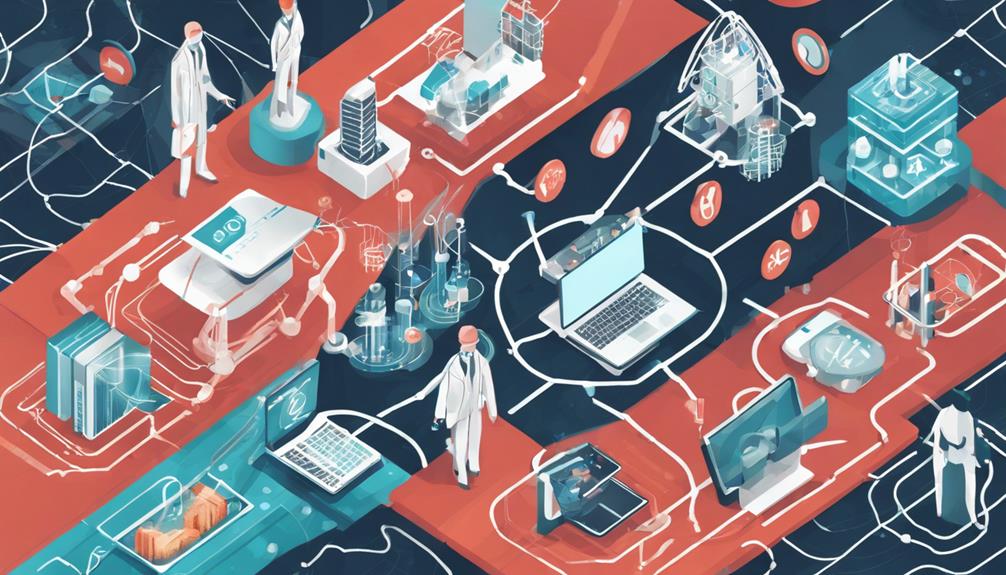
Across various industry sectors, distinct patterns emerge in the adoption and utilization of artificial intelligence within cybersecurity strategies. The BFSI sector, encompassing banking, financial services, and insurance, leads in AI-driven advancements for fraud detection and risk management. This sector is increasingly embracing the zero-trust model to enhance security measures.
Simultaneously, the government and defense sectors are witnessing a surge in demand for AI integration following cyber incidents, highlighting a growing emphasis on security intelligence. In the fintech industry, the adoption of AI is on the rise to combat financial crimes and fraud effectively.
Machine learning tools play an essential role in various industries, aiding in the fight against fraud, phishing attacks, and the detection of fake records. Understanding these market dynamics is important for organizations looking to bolster their cybersecurity posture and stay ahead in an ever-evolving threat landscape.
Competitive Landscape Analysis
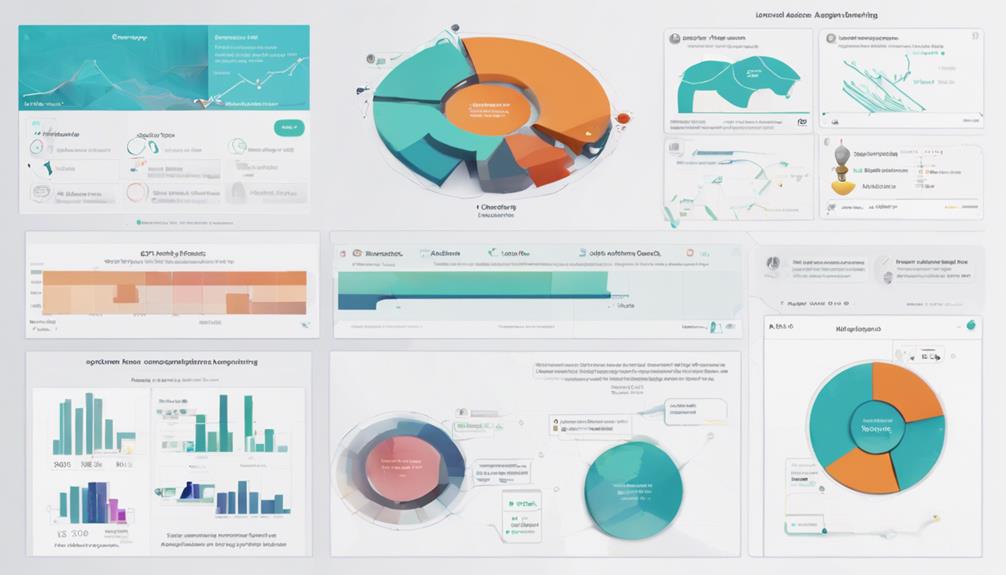
In evaluating the competitive landscape of AI for cybersecurity, it becomes evident that major market players such as NVIDIA, Intel, IBM, and Amazon Web Services are notably shaping the industry.
The market is further enriched by notable contributors like CrowdStrike, NortonLifeLock, and Cylance Inc, all focusing on enhancing cyber defenses with AI technology.
Recent industry acquisitions, such as Thoma Bravo considering acquiring Darktrace, signify the continuous drive for cybersecurity advancements through strategic partnerships and mergers.
Additionally, partnerships like NVIDIA with Oracle and Samsung Electronics Co., Ltd with LPDDR5X DRAM are driving market innovations, fostering a collaborative environment for technological growth and security enhancements.
Regional Market Dynamics

Asia Pacific's burgeoning AI for cybersecurity market is poised for significant growth driven by increasing adoption of advanced security solutions. The region's proactive stance towards embracing cutting-edge technologies to combat cyber threats positions it as a key player in the global market analysis. With China leading the pack due to its economic progress and rising tech-savvy population, Asia Pacific showcases immense growth potential in the AI for cybersecurity sector.
In comparison, Europe's focus on defense expenditure to counter cyber threats from hostile entities underscores its promising growth prospects in the AI for cybersecurity market. This emphasis aligns with the region's commitment to bolstering its cybersecurity infrastructure and staying ahead of evolving security challenges.
Meanwhile, North America's strong market presence stems from its continuous pursuit of technological advancements and robust cybersecurity measures.
As global market analysis reveals the varying dynamics and opportunities across regions, the demand for AI-powered cybersecurity solutions continues to rise worldwide, reflecting a growing necessity for innovative security measures in an increasingly digital landscape.
Future Growth Opportunities
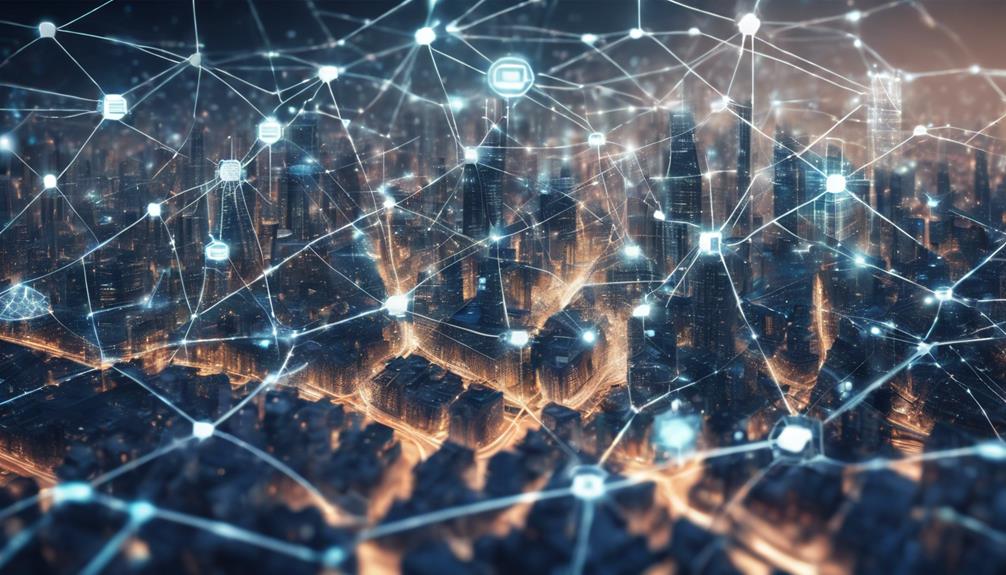
With the global AI for cybersecurity market projected to reach $60.6 billion by 2028, opportunities for future growth are emerging through advancements in automation and threat intelligence platforms. The increasing demand for AI-driven cybersecurity solutions presents a promising landscape for innovation and development in the industry.
Here are five key growth opportunities in the AI for cybersecurity market:
- Automation of Incident Response Tasks: Streamlining incident response processes through automation enhances efficiency and reduces response time.
- AI-Driven Threat Intelligence Platforms: Utilizing AI to analyze and predict potential threats enables proactive security measures.
- Integration of AI, Cognitive Computing, and Automation: Combining these technologies strengthens cybersecurity defenses and adaptability.
- Collaboration Between Humans and AI: Building synergies between human expertise and AI capabilities optimizes security operations.
- Quantum-Resistant Encryption and Blockchain Integration: Implementing advanced encryption methods and blockchain technology fortifies data protection against evolving cyber threats.
Emerging Threat Landscape

The dynamic nature of cybersecurity threats is evident in the rapid evolution of cyber attacks, necessitating proactive measures to mitigate risks and safeguard digital assets.
Ransomware attacks soared by 151% in 2020, while phishing attempts spiked by 220% amid the vulnerabilities exposed by remote work during the COVID-19 pandemic. Notably, insider cyber threats are on the rise, with 34% of data breaches involving internal actors in 2020.
To combat these escalating risks, small and medium enterprises (SMEs) are increasingly turning to cloud-based security solutions. However, the underutilization of AI technology for detecting insider threats poses a significant challenge for organizations.
Embracing AI in cybersecurity can enhance threat detection capabilities and strengthen defense mechanisms against evolving cyber threats. By harnessing AI's power in combination with cloud-based security solutions, businesses can proactively safeguard their digital assets and stay ahead of the ever-changing threat landscape.
Strategic Recommendations
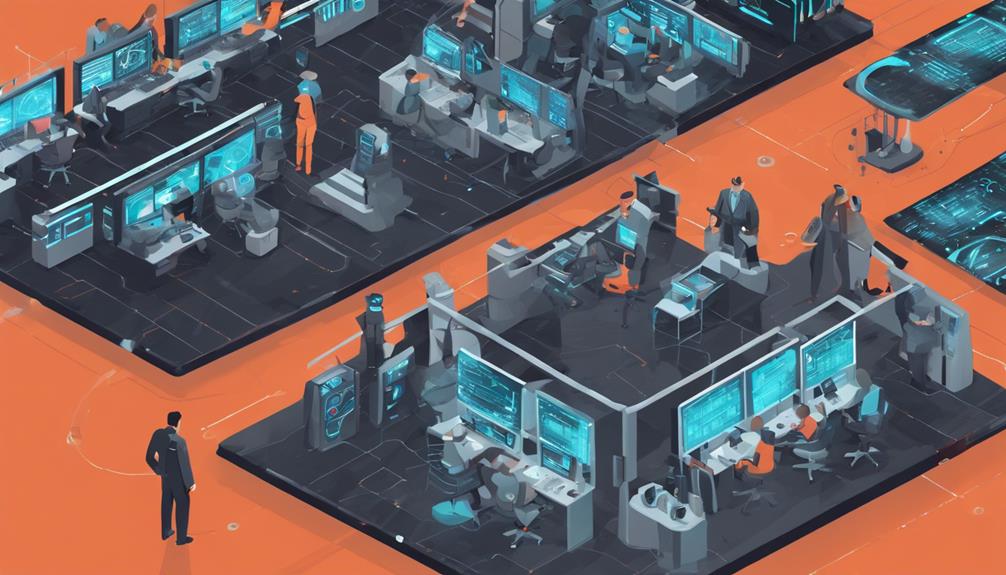
To excel in the dynamic cybersecurity landscape, it is essential to strategize AI implementation, develop industry-specific solutions, and prioritize training and integration.
By adopting these key points, organizations can strengthen their defenses, proactively identify threats, and stay ahead of emerging cyber risks.
Embracing AI in a targeted and thorough manner will empower businesses to navigate the complexities of cybersecurity with confidence and resilience.
AI Implementation Strategies
Strategically incorporating AI-driven threat intelligence platforms is essential for optimizing cybersecurity measures in the current technological landscape.
To enhance AI implementation strategies in cybersecurity, consider the following recommendations:
- Automate Incident Response Tasks: Implement AI-driven platforms to automate incident response tasks, improving response time and accuracy.
- Integrate AI, Cognitive Computing, and Automation: Develop a mid-term roadmap that integrates AI, cognitive computing, and automation to bolster cybersecurity strategies effectively.
- Collaborate Between Humans and AI: Foster collaboration between human experts and AI systems to leverage the strengths of both in threat detection and response.
- Incorporate Quantum-Resistant Encryption and Blockchain: Include quantum-resistant encryption and blockchain technology in long-term cybersecurity roadmaps for robust protection against evolving threats.
- Focus on Real-Time Threat Detection Solutions: Utilize real-time threat detection solutions driven by AI, machine learning, and cloud integration to enhance cybersecurity defenses proactively.
Industry-Specific Solutions
Industry-specific sectors such as BFSI, government & defense, manufacturing, and infrastructure necessitate tailored strategic recommendations for implementing AI solutions in cybersecurity. In the BFSI sector, focusing on enhancing fraud detection, risk management, and threat intelligence through AI tools is essential to safeguard sensitive financial data. Government & defense industries benefit from proactive cyber defense and incident response mechanisms powered by Artificial Intelligence in Cyber Security. For the manufacturing sector, real-time threat detection, network security, and data protection are key areas where AI can play a vital role. In the infrastructure sector, utilizing AI tools for endpoint security, cloud security, and application security can significantly enhance overall cybersecurity posture. Implementing industry-specific solutions ensures that organizations can address sector-specific challenges effectively and stay ahead of evolving cyber threats.
| Industry Sector | Strategic Recommendations |
|---|---|
| BFSI | Enhance fraud detection, risk management, and threat intelligence |
| Government & Defense | Implement proactive cyber defense and incident response mechanisms |
| Manufacturing | Utilize AI for real-time threat detection, network security, and data protection |
| Infrastructure | Enhance cybersecurity posture with AI tools for endpoint security, cloud security, and application security |
Training and Integration
In aligning with the tailored strategic recommendations for implementing AI solutions in cybersecurity across various industry sectors, a key focus lies in developing strategic training programs for the integration of AI to enhance detection accuracy and response effectiveness.
To secure successful AI integration and optimize threat identification capabilities, consider the following strategic recommendations:
- Implement strategic training programs tailored to the specific needs of your cybersecurity infrastructure.
- Continuously update and refine AI models to adapt to evolving cyber threats and attack techniques.
- Integrate AI tools effectively into existing security systems to maximize resource allocation.
- Train AI models using diverse and real-world data sets to enhance their ability to detect sophisticated cyber threats.
- Foster a culture of ongoing learning and development to support the integration of AI tools into your cybersecurity framework.
Frequently Asked Questions
How Big Is the AI Cybersecurity Market?
The AI cybersecurity market is expanding rapidly, with a projected revenue of $60.6 billion by 2028. Key drivers include increased adoption of real-time threat detection solutions and demand for AI, ML, and cloud integration. Major players include NVIDIA, Intel, IBM Corporation, Amazon Web Services, and Microsoft.
How Does AI Help With Cybersecurity?
In the domain of cybersecurity, AI acts as a vigilant sentinel, tirelessly scanning digital landscapes to detect and thwart malevolent intruders. Through advanced algorithms, AI predicts threats, accelerates response times, and fortifies defenses against evolving cyber dangers.
What Is the AI Trend in Cyber Security?
The current trend in cybersecurity involves leveraging AI technologies such as machine learning and natural language processing to enhance threat detection and response capabilities. This integration of AI aims to bolster cybersecurity measures by improving real-time threat detection and automating incident response tasks.
Is AI Going to Replace Cyber Security?
While AI enhances cybersecurity, it's not set to replace it. Human expertise remains crucial for decision-making. AI strengthens defense mechanisms by providing real-time monitoring, anomaly detection, and predictive analytics to counter evolving cyber threats effectively.
Conclusion
To sum up, the AI for cybersecurity market is on the verge of substantial growth and presents numerous opportunities for organizations to enhance their security measures.
Just as a skilled locksmith can secure a home with precision and expertise, AI technology can fortify digital systems against cyber threats with advanced algorithms and machine learning capabilities.
By embracing this innovative solution, businesses can safeguard their data and networks effectively in an increasingly complex and evolving cybersecurity landscape.


